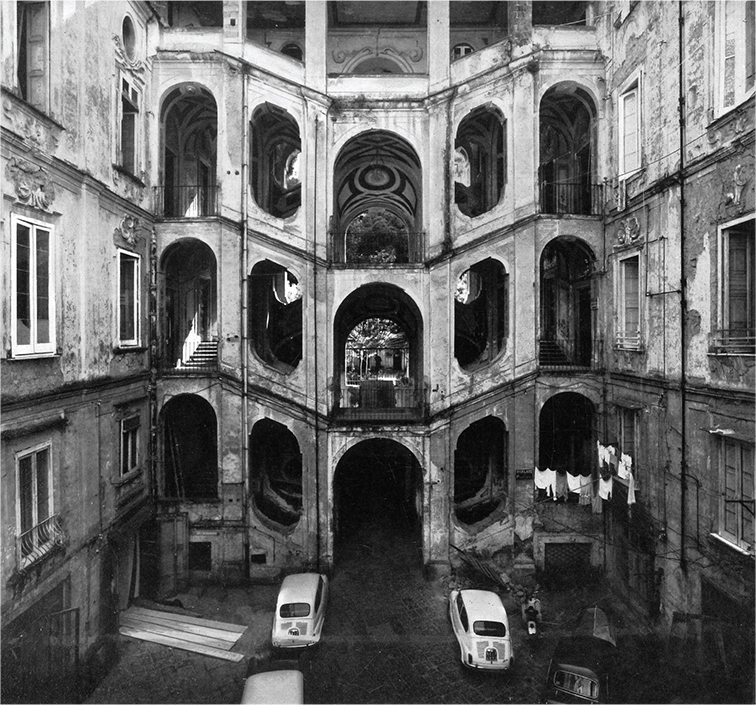



Behind the facade, the commons!
translation by Susan Jenkins
“For global cities a key issue with citizen participation is how people can feel both physically and socially connected to others whom, necessarily, they cannot know. Democratic space means creating a forum for these strangers to interact.”
Richard Sennett and Pablo Sendra, Designing Disorder
In the 1960s the artist’s collective Situationists International organized so-called derivés [literally: “driftings”], wanderings through the city. Guy Debord, philosopher, filmmaker and one of the foremost Situationists, wrote: “In a derivé one or more people, for a certain period, drop their relationships, their work, their leisure activities, and all their other usual motives for movement and action, and let themselves be drawn by the attractions of the terrain, and the encounters they find there.” In other words, the intention of the wanderings was to experience and use the city in a different way than we normally do. For example, by not taking the fastest route from A to B, but by walking according to certain instructions, or steered by chance.
The purpose of such wanderings was to restore a kind of playfulness in our relation to our environment, which deviated from the calculated efficiency with which planners and project developers usually approached the city. I recognize the same kind of playfulness in the projects of this edition of Welcome Stranger. This summer Welcome Stranger invited four artists—Esther Tielemans, Lily van der Stokker, Radna Rumping and Kévin Bray—to create works of art in various streets of Amsterdam, on or near their own homes. The fact that these projects are located outside the conventional spaces of the “official” art institutions (museums, art fairs, galleries) influences the aesthetic experience and the urban experience at the same time. It makes them public, yet simultaneously intimate (because they are literally next to the artists' homes), and despite the aforementioned playfulness, you also have the idea that a lot is at stake.
Inspired by the Situationists, student activists in May '68 coined the slogan “Sous les pavés, la plage!—under the pavement, the beach!” Beneath the thin layer of order, asphalt and cobblestones lay limitless opportunities for play, for leisure and relaxation, for building sandcastles or castles in the sky. (Let's set aside for now the fact that the paving stones were then used to pelt police officers.) Around the same time, Constant Nieuwenhuijs, also a Situationist, conceived and developed his grand designs in the form of sketches, models and paintings, for New Babylon. It was the city of the future, in a world without work, in which we could roam freely, create and play: a city for homo ludens, the playing human.

Under the paving stones, the beach – graffiti on a wall in Paris, May 1968
Since then, however, the room for playful movement in cities has decreased rather than increased. This applies to both public and private urban space, both of which are increasingly characterized by efficiency, organization and rational control. It is a phenomenon that has many sides and goes by several names. In part we now know it as “gentrification”—the process by which a neighborhood, or even an entire city, which is socially and culturally diverse and valued for its lively atmosphere, becomes attractive to new, wealthy residents, making houses and rents skyrocket, so that the “original” inhabitants are driven away and with them the very socio-cultural diversity that started the process. This goes hand in hand with the “financialization” of the city, in which houses are mainly treated as investment objects in a global real estate market. Sometimes they are no longer even inhabited, only used for speculation; a city like London has tens of thousands of such “ghost apartments”, but it is also a growing trend in Amsterdam.
We also sometimes speak of “musealization”, the city as a fixed museum object (as in the case of Venice or Dubrovnik), or “Disneyfication”, the process in which the public space of the city comes under the influence of the tourism industry and slowly but surely is turned into an amusement park (think the Amsterdam Red Light District). Now you might think that Disneyfication would actually increase the space for play, but nothing could be further from the truth. After all, anyone who has ever been to Disneyland knows that the fun there is subject to a strict regime, carefully planned and thought out in advance. Homo ludens has no place there.
It holds true that in order for these processes to happen, cities must become more orderly: cleaner and more organized, but also more homogeneous, boring, and predictable. And thus, they undermine precisely what makes cities attractive, what makes a city a city. Ebenezer Howard already claimed in his classic The Garden Cities of To-morrow (1898) that a city derives its value from the fact that many people with different knowledge, skills, cultural backgrounds, etc., live close together—the sum of which is greater than the whole of its parts. Together they “produce” the city. It is not without reason that cities have traditionally been seen as the engine of scientific and cultural innovation, because new ideas could easily spread and mix with diverse sources of traditional knowledge and culture.
Porosity
We make generally a rather clear distinction between public space and private space: the first is held by the state or a local government, the second by a person or venture. In a city, at first glance the two seem neatly separated: as long as you are at home, you are in a private space, and the moment you step over the threshold of your front door, you enter public space. And there, other rules apply--those that prioritize public order.
If we want to restore aspects of play to the city, it is indeed interesting to think about spaces in-between: between public and private. The philosopher Walter Benjamin, during a visit to the city of Naples in the 1920s, described the “porosity” of life in this city, in which public and private were as porous as the lava rock on which it is built: "Every private attitude and activity is flooded with the flows of communal life", said Benjamin. He continues:
"So the house is not so much the refuge to which people retreat, but the inexhaustible reservoir from which they flood out. Life bursts not only from doors, not only into front yards, where people on chairs do their work (since they have the ability to make their bodies into tables). Entire households hang down from balconies like potted plants. Baskets descend on ropes from the windows on the upper floors for mail, fruit and cabbages. Just as the living room flows into the street with chairs, stove and altar, so the street, but much noisier, pours into the living room. Even the humblest rooms are as packed with wax candles, porcelain saints, sheaves of photographs on the walls and iron bedsteads as the street is with handcarts, people and lights."
 Palazzo Sanfelice, large courtyard staircase. Photograph c. 1960. Published in Mario Capobianco, Scale settecentesche a Napoli, in: ‘L’Architettura: Cronache e storia’, 1962, n. 84.
Palazzo Sanfelice, large courtyard staircase. Photograph c. 1960. Published in Mario Capobianco, Scale settecentesche a Napoli, in: ‘L’Architettura: Cronache e storia’, 1962, n. 84.
The artwork that has developed within the framework of Welcome Stranger embodies for me exactly this space of play, and through that this porosity of private and public space. In some cases, they appear as protrusions of the private space of the artist onto the street; in other cases, the street or public space is reflected or projected onto the house. Sometimes this reflection takes place literally, as in the green foil of the work Scenery by Esther Tielemans, which sparkles at the passer-by like candy wrappers or the foil of a hazelnut bonbon. The title suggests a green landscape, but also the greenscreen used in films to project imaginary backgrounds. With Roof terrace with bubble bath, Lily van der Stokker delivers a kind of parody on the “building frenzy” in her neighborhood, in which neighbors try to add extra square meters to their private space, for example by widening their roof terrace or balcony. At the same time, the work is reminiscent of the garish advertising that often mars the public space in cities, and the commercialization of the home, which is encouraged via Airbnb or similar rental sites.
Interestingly, in both of these cases the work has been installed on the facade of the house. The word “facade" often has a negative connotation in our everyday language when we use it figuratively: to “keep up a facade" means to pretend to be better than you are. But pretending also implies playing a game – which brings us back to the play space. In these situations, the facade is literally presenting a facade, creating a space for play—the play of private and public, inside and outside, and the free play of the imagination.
The Urban Commons
According to various political philosophers, in addition to public and private, there is also a third category, which has fallen into oblivion in Western thinking and in the organization of our space. That is the “common” or “commons”, the space which is neither owned by the state, nor by any private person or company, but which belongs to no one and yet is available to everyone, because everyone also contributes to the maintenance of it. From a purely legal point of view, commons are scarce in an urban environment; there is the single community garden or shared square, but that's about it. You could, however, see the entire city as a commons—as a co-created source of value that is also essential for the survival of everyone who participates and contributes to it. Yet the urban commons also functions very differently from the traditional spaces it usually refers to (such as communal forests and fields), in that the multiplicity of uses by many different people does not reduce or exhaust the resource, but rather (as mentioned above) contributes to its further enrichment.
According to the Greek architect and urban activist Stavros Stavrides, this is precisely what makes the urban commons so interesting and fertile. A commons can also become homogeneous and homogenizing, only benefiting a certain closed community that maintains it. We know of these also in cities, as various types of gated communities. São Paolo is a notorious example of a city made up of homogeneous enclaves, whose borders are guarded by fences, walls and surveillance systems. But boundaries can sometimes be less tangible, and consist of looks from people that give you the idea that you don't belong there, or of remarks that warn you about places that you should avoid—particularly as a woman, alone, at night. Where in the past the walls only ran around the city to protect the inhabitants against the “barbarians at the gate”, they now often run right through it.
However, Stavrides is interested in what he calls “common space”. He also calls this “threshold space”, which occupies the border between inside and outside, public and private, or between different parts of a city. With artist Radna Rumping, who translates her personal associations with the Hoofdweg in Amsterdam into written word and public radio broadcasts for Welcome Stranger, we can add: between inner (psychological) space, and (physical) outer space. Although the threshold also forms a boundary, it is less strict and closed than that of the enclave; it is literally a “lower threshold” presenting less resistance to being traversed. The idea of common or threshold space also does not imply that borders should be lifted or erased altogether. Just as a musical instrument such as a violin or guitar requires a certain degree of both openness and closedness—in other words, a certain porosity—in order to be able to produce sound at all, and thus be able to play, it is exactly where different parts or elements touch or come in transitory contact with each other that a dialogue can arise between the strange and the familiar. Perhaps it is not only about making the strange familiar, but also about making the familiar, in the words of artist Kévin Bray, strange—as he himself does with a secret message in the form of a rebus on his balcony.
According to Stavrides, the common space must be distinguished from public space, which, as mentioned, is always owned and managed by the government, and is therefore always governed by a (top-down) exercise of power. He says: “Common space is shared space. Whereas public space, as a space marked by the presence of a prevailing authority, is space ‘given’ to people according to certain terms, common space is space ‘taken’ by the people.” In other words, it comes down to reclaiming the space from the real estate entrepreneurs, the city marketers and the tourism tycoons, who reap the benefits of the value that we, as residents of the city, generate together. After all, it is precisely the atmosphere of a city or neighborhood that is often packaged and sold as a commodity by these interests, even though they themselves have not contributed to it. On the contrary: they regularly contribute to the destruction of that atmosphere, and thus exhaust the very resource that makes the city livable.
Designing Disorder
What can be the role of art in reclaiming urban spaces of play? That role is fraught with ambiguity, because artists, albeit unconsciously and unwittingly, have often also played a key role in gentrification processes. The key to the "creative city", according to Richard Florida, was that you no longer had to attract companies to your city, wherein jobs would automatically follow; no, it was just a matter of attracting young, creative workers to your city, and then the economic boom would naturally follow. To achieve this, it was important that a city was hip and happening—that there was enough art and culture, restaurants, alternative shops, a lively gay scene, and so on. Districts that need to be developed or “regenerated”—old working-class neighborhoods or industrial areas—were (temporarily) made available to artists, young creative professionals, and students. “Lokhipsters” [literally: bait-hipster], city architect Winy Maas once aptly called them, because they are the vanguard who make the neighborhood attractive to other, more wealthy residents.
Artists therefore became engines of gentrification, and thus paradoxically of homogenization and its attendant loss of the urban experience of play. But can art also counter this loss? Sociologist Richard Sennett and urban designer Pablo Sendra recently published the book Designing Disorder (2020), in which they argue, in line with the above theories, that a city benefits from openness, incompleteness, and porosity, and a certain degree of disorder. Only in this way can a city really be for everyone and anyone, instead of just meeting the needs of a limited segment of the population. They write: “When the city operates as an open system…it becomes democratic not in the legal sense, but as a tactile experience.” Democracy, in other words, is not only hidden in laws and regulations, in our political systems and institutions, but just as much in our built space and living environment, and the way in which we experience them.
This brings them, however, to the paradox embedded in the title, for how can you design disorder, when “design” inherently implies order. For urban designers, according to the authors, it is indeed important not to hammer out their plans completely but to create structures and systems that leave sufficient room for people to use them in unexpected ways, and create social interaction and “innovative forms of communal living”. Stavrides agrees: his “common space” is not something you can create (as an individual), but something that has to happen, as a collective practice, and for which you can at most create conditions where it can emerge.
This is also the way I understand the artist projects of Welcome Stranger: they tilt our view on the urban space, they create space for the unexpected, and thus offer the possibility to resist the invisible hand of the planners, the real estate entrepreneurs, the marketers. The artists turn the unsuspecting passer-by into a visitor or participant: places that you would otherwise probably have passed without thought, places that at first glance might have seemed uninteresting or where there was nothing to do (which usually means: nothing to consume), now become charged with meaning. This meaning is not (yet) fixed, because it is sufficiently open and porous enough to enter into a dialogue with the experience and interpretation of that passer-by. In short: it becomes an invitation or incentive to rediscover the city, perhaps even to help redesign it—and reclaim space for play, for commoning, and for the imagination.
*
Bio Thijs Lijster is an assistant professor of art and cultural philosophy in the Faculty of Arts at the University of Groningen and a postdoc researcher at the Culture Commons Quest Office of the University of Antwerp. He studied philosophy in Groningen and New York, and previously taught in Amsterdam. He has published the books De grote vlucht inwaarts (2016), Walter Benjamin and Theodor W. Adorno on Art and Art Criticism (2017), Kijken, proeven, denken (2019) and Verenigt U! (2019). He also regularly writes for newspapers and magazines such as Trouw, De Groene Amsterdammer, Metropolis M and Filosofie Magazine. He is currently writing a book about the commons.
